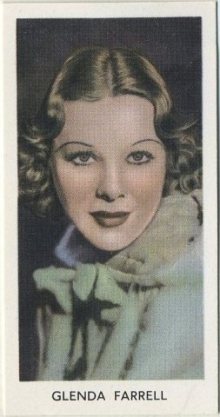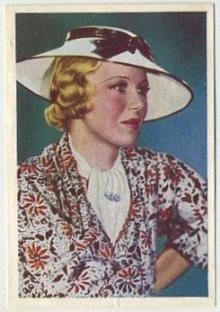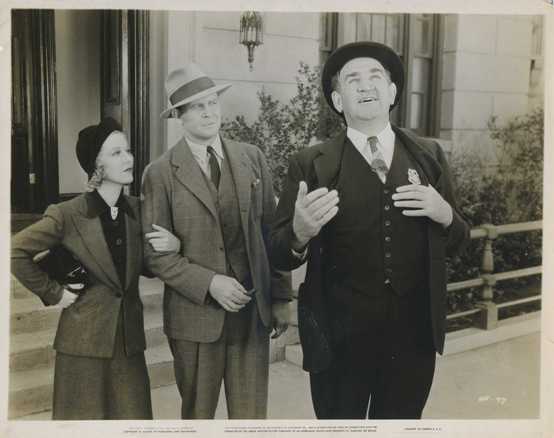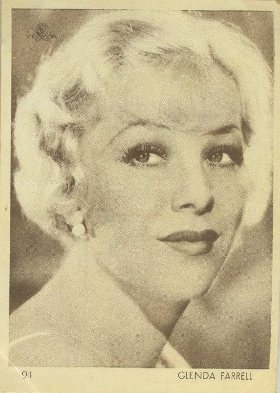 Publicity always stressed that the real Glenda Farrell was nothing like Torchy Blane or the other characters she played on screen during her 1930s Hollywood peak. Thank goodness for Miss Farrell because that much manic energy would have certainly led to an early burn out! But up on the screen in bites of an hour or a little more Glenda Farrell grabs our attention by making her characters, if not the most interesting, then the most intriguing figure in any scene, whether they’re intended to be or not. She doesn’t steal scenes: She enlivens them.
Publicity always stressed that the real Glenda Farrell was nothing like Torchy Blane or the other characters she played on screen during her 1930s Hollywood peak. Thank goodness for Miss Farrell because that much manic energy would have certainly led to an early burn out! But up on the screen in bites of an hour or a little more Glenda Farrell grabs our attention by making her characters, if not the most interesting, then the most intriguing figure in any scene, whether they’re intended to be or not. She doesn’t steal scenes: She enlivens them.
Before Torchy came Glenda’s gold diggers including seven pairings with Joan Blondell, who became a lifelong friend. She wasn’t quite yet who she would become in Little Caesar (1930), but was on her way by the time she was causing trouble for Paul Muni in I Am a Fugitive from a Chain Gang (1932). Her reporter in Mystery of the Wax Museum (1933) laid the groundwork for much of what was to come while her earthy Missouri Martin from Lady for a Day (1933) filled in much of what had still been missing.
Good or bad, Farrell’s characters often were in some form of ascent from the gutter as they chiseled a path to a new and improved background. If she were a man we’d call many of her characters crude, yet at the same time, perhaps more than any other Golden Age screen persona, she struck a blow for equality through her hard edged working girls. Especially her reporters.
When it comes to comparison’s sake, film historian Dan Van Neste hit the target when writing, “In her films, she was Lee Tracy and Mae West, with a dash of Joan Blondell all bundled up in one dynamic package.”
 On screen Farrell exudes a workaholic drive, enhanced by an onslaught of dialogue, most certainly read at three to five times the intended speed. The understated mainstream feminism of the era is also wrapped up inside all of that energy. Farrell’s characters honored de facto boundaries, but pushed them to the limit before letting the boys do it their way–a way which often found Glenda bailing them out at the end anyway. While she was no traditional beauty Glenda definitely toted her fair share of sex appeal in her gold diggers tool box. She comes across with all the humor and sauciness associated with Blondell, with the scales tilted even more in the slightly older Farrell’s direction when they’re teamed. She usually set their course and got to serve up the snappy punch lines in response to the reactions of her more naive pal.
On screen Farrell exudes a workaholic drive, enhanced by an onslaught of dialogue, most certainly read at three to five times the intended speed. The understated mainstream feminism of the era is also wrapped up inside all of that energy. Farrell’s characters honored de facto boundaries, but pushed them to the limit before letting the boys do it their way–a way which often found Glenda bailing them out at the end anyway. While she was no traditional beauty Glenda definitely toted her fair share of sex appeal in her gold diggers tool box. She comes across with all the humor and sauciness associated with Blondell, with the scales tilted even more in the slightly older Farrell’s direction when they’re teamed. She usually set their course and got to serve up the snappy punch lines in response to the reactions of her more naive pal.
While the Torchy Blane movies were a B series they offered Farrell, often the second or third billed actress in previous titles, a chance to star. She elevated these movies by sheer force of personality and talent making Torchy the ultimate representation of who Glenda Farrell was on screen during the 1930s.
“Sure I like Hollywood,” Glenda told a reporter in 1939, soon after she left Torchy Blane behind for good. “I’d be awfully foolish if I didn’t. However, I’m getting so I abhor newspaper women roles such as Torchy Blane. Warners were definitely typing me, so when I had the opportunity to play summer playhouses and emerge from contract obligations with the studio I was extremely elated. Why do they type actors?” (Herzog).

Early 1930s Warner Brothers publicity shot features Glenda Farrell in the center with Patricia Ellis at right and Ellis’ mother, Mrs. Alexander Leftwich, at left, each holding a leopard cub.
Glenda Farrell was born in Enid, Oklahoma on a date typically reported to be June 30, 1904, but the research of Hardwicke Benthow points to that date actually coming a few years earlier, in 1901. The 1920 and 1940 censuses appear to back up Benthow’s assertion.
Farrell began acting soon after her family moved to Wichita, Kansas, where she made her debut at age seven as Little Eva in a performance Uncle Tom’s Cabin. Given the likely inaccuracy of Farrell’s usual given date of birth, take these ages with a grain of salt, or at least be willing to do a little addition.
The Farrells moved to San Diego where teenage Glenda joined the Virginia Brissac Stock Company. No matter how you do the math, Miss Glenda Farrell of San Diego would have still been a teenager when she made the third honor roll in Motion Picture Magazine’s “Fame and Fortune Contest,” an honor that got her picture inside their April 1919 issue along with this brief biography:“Miss Glenda Farrell was born in Oklahoma, and has had some experience in the chorus, vaudeville and camp entertainments. She has light brown hair, dark-gray eyes and is five feet three inches in height.”
In 1920 Farrell was paired with Thomas Richards at a Navy benefit ball in San Diego. They married a few weeks later and tried to make ends meet with a vaudeville dance act. Their son Tommy was born in 1921, but Glenda and Richards, who drank and grew abusive towards his wife, were officially divorced in 1929. In 1932 their son legally took his mother’s surname. Tommy Farrell would later have a successful show business career himself becoming especially known for his B-Western movie sidekicks of the 1950s. He died in 2004.
In 1929 Glenda left Tommy with her mother and headed east where she replaced Erin O’Brien Moore in the cast of Skidding on Broadway at the Nora Bayes Theater. Farrell played Marion Hardy in the Aurania Rouverol play that later served as the basis of MGM’s Hardy Family series. By April 1929 the Brooklyn Daily Eagle reported that she had played the role 355 times to date!From Skidding she’d also play in Divided Honors, Recapture, which was written by Preston Sturges, and as Alice Brady’s daughter in Love, Honor and Betray, with a cast that also included Robert Williams, George Brent and Clark Gable, before gaining her first big movie break as Olga, the girl who comes between Douglas Fairbanks, Jr. and Edward G. Robinson, in First National’s Little Caesar (1931).
Glenda’s previous film work consisted only of a bit role in Lucky Boy (1928) for Tiffany-Stahl Productions and a featured part in Warner Brothers comedy short The Lucky Break (1930) starring Harry Fox. In July 1930 Film Daily announced that Glenda had been cast in Little Caesar and by the time it was released she was back on Broadway in a successful run of On the Spot for the Shuberts at the Forrest Theater.
There is enough cross-pollination between Farrell’s movie origins and blossoming stage career at this point to make for a confusing timeline. Despite tossing in the element of her current assignment, another Sturges play, this time off-Broadway at Chamberlain Brown’s Westchester Theater, Glenda offered some clarity in a July 1931 interview: “While I was acting in Little Caesar I was offered my present role in Strictly Dishonorable, but unfortunately had to decline. Then, after I had signed with On the Spot, I was again offered the same part, and again I was forced to refuse. So when Mr. Brown asked me to do the part with his Mount Vernon company, I felt that my chance had arrived.”
At the time Farrell conceded “the talking pictures offer immense salaries,” but felt that the theater was “the foundation of the actor’s profession.” She added, “I shall continue to appear in pictures now and again, when a good part offers, but, on the whole, I do not believe I will make another trip to Hollywood this year.”
She was correct, but it was back to Broadway where she was a big enough hit in 1932’s Life Begins to catch the eye of Jack Warner, who cast her in Warner Brothers’ film adaptation later that year after putting Farrell under long-term contract. She would not return to Broadway until 1941, but she’d have a good deal of financial security when she did.
Glenda Farrell was kept as busy as any of the Warner contract players, appearing in five films in 1932, including Mervyn Leroy’s I Am a Fugitive from a Chain Gang; eleven in 1933 beginning with that important turn as proto-Torchy girl reporter in Mystery of the Wax Museum and her appearance on loan to Columbia for Frank Capra’s Lady for a Day, coming at a time when Glenda was dating Capra screenwriter Robert Riskin. She closed out 1933 in her first pairing with Blondell in Havana Widows. There were nine more movies in 1934, none of them classics, but most of them enjoyable rediscoveries, including Hi, Nellie! opposite Chain Gang star Paul Muni again, unintentionally a bad influence on Little Caesar himself, Edward G. Robinson, in Dark Hazard, and two more teamings with Blondell; Gold Diggers of 1935 was the first of seven films for Farrell in that titular year; six more movies with Glenda in 1936, a year that ended for her with Gold Diggers of 1937; New Year’s 1937 saw the release of Smart Blonde and the beginning of the Torchy Blane franchise which was to last through 1939, though Farrell also appeared in several non-Torchy roles for Warners throughout 1937 and ‘38.Glenda Farrell starred opposite Barton MacLane in seven of Warner Brothers’ nine Torchy Blane movies, a teaming that worked so well that the studio actually brought the pair back, each under new contracts, after replacements Lola Lane and Paul Kelly failed to carry the torch in 1938’s Torchy Blane in Panama. After completing the three additional Torchy titles that they were contracted for, Warner Brothers once again tried to replace Farrell and MacLane, this time with Jane Wyman and Allen Jenkins, and that finished the series. Wyman actually does a fine job, even if she is playing Glenda Farrell as Torchy Blane, but the almost always affable Jenkins is too great a departure as Detective Steve McBride, unable to pull off MacLane’s natural slow burn that always seethed somewhere under even his more likable characters like McBride. Character actor Tom Kennedy actually appears in all nine Torchy Blane movies as dimwitted Gahagan, McBride’s poetry spouting underling.

Tom Kennedy in the foreground with Glenda Farrell and Barton MacLane likely listening to some poetry from behind.
Farrell’s Torchy Blane was a dynamo reporter who rushed about solving crimes for boyfriend McBride while creating headlines for herself. She’s Wax Museum’s reporter with a few years of experience on her, unable to be bullied off any story by this point, even for the sake of McBride, who is always under pressure from above to keep Torchy off of his heels. Torchy always finds a way to outdo him and the entire police force, usually by benefit of her handling of eager to please Gahagan.
There are no masterpieces here, just enjoyable, fast whodunits with elements that are sometimes forced, but whose stories are overcome by Kennedy, MacLane and, especially, Farrell. No wonder the series would not work with replacements.
The greatest legacy of Torchy Blane came years after the fact when Superman’s creators, Joe Shuster and Jerry Siegel, named Farrell’s interpretation of the character as inspiration for their own Lois Lane. While the Superman character gained her alliterative name by way of one of Farrell’s replacements, Lola Lane, the character herself spun out of Glenda’s Torchy. Today, like so many Golden Age heroes, Torchy has reemerged from obscurity thanks to sporadic appearances on Turner Classic Movies and has recently been further revitalized via a boxed set of DVDs courtesy the Warner Archive.
With Torchy Blane and Warner Brothers behind her Glenda Farrell was finally able to return to the stage. After an unlikely yet successful run in Anna Christie at the Westport Country Playhouse, Farrell co-stared with Lyle Talbot and Alan Dinehart in the long-running Separate Rooms, a show that played over six hundred times on Broadway throughout 1940 and ‘41.
“There’s something more satisfying about working in a play,” Farrell told syndicated columnist Bob Thomas in 1952. “You get that immediate response from the audience, and you feel that your performance is your own. In pictures, you get frustrated because you feel you have no power over what you’re doing”
During the run of Separate Tables Farrell, by then divorced for over a decade, met Dr. Henry Ross. They married in 1941.
 There are two stories as to their meeting, with period reportage of their wedding pointing to a backstage party during the run of Separate Tables. A more romantic version is supplied by Glenda’s son, Tommy Farrell, who told writer Daniel Bubbeo that his mother had sprained her ankle during Separate Tables and was treated backstage by Dr. Ross, who had been called forth from the audience (80). Whatever the case, their union was a successful one that lasted the rest of Glenda’s life.
There are two stories as to their meeting, with period reportage of their wedding pointing to a backstage party during the run of Separate Tables. A more romantic version is supplied by Glenda’s son, Tommy Farrell, who told writer Daniel Bubbeo that his mother had sprained her ankle during Separate Tables and was treated backstage by Dr. Ross, who had been called forth from the audience (80). Whatever the case, their union was a successful one that lasted the rest of Glenda’s life.
Unlike many actresses who either find a new husband or suddenly enter their forties, Glenda Farrell kept busy. Very busy.
Her husband, a West Point graduate, was a highly respected surgeon who enlisted in the Army during World War II and was General Eisenhower’s chief of health in Europe by war’s end. Glenda, meanwhile, was back on Broadway briefly in The Life of Reilly and, despite taking an apartment in Manhattan and buying a home in upstate Brewster, New York, returned to Hollywood, where she appeared in supporting roles in Johnny Eager (1941) and The Talk of the Town (1942), among other titles.
Farrell’s movie career would stretch to Elvis Presley and beyond, while she continued to act on stage and appear on radio and television. It was TV that brought Farrell her only bit of mantelpiece hardware, in 1963 when she captured an Emmy Award for her appearance on an episode of Ben Casey.
Farrell retired in 1968 after appearing in the movie Tiger by the Tail, but soon grew moody and obliged her husband’s request that she call her agent and get back to work. This led to one final plum role on Broadway as Julie Harris’ mother in Forty Carats at the Morosco Theatre.
Unfortunately Glenda Farrell was only with Forty Carats for two months before ill health forced her off the stage. The non-smoker was diagnosed with terminal lung cancer and died in her Park Avenue apartment on May 1, 1971, age 69 if those historical records are correct.
Owing to her husband’s background Glenda Farrell is the only actor buried at the United States Military Academy at West Point. In 1977 when Dr. Ross sold their Brewster, New York home he deeded 36 acres of the property to the Putnam County Land Trust establishing the Glenda-Farrell-Henry Ross Preserve. Ross died in 1991 at age 89 and was buried alongside Glenda at West Point.

1963 press photo pictures Glenda Farrell in anticipation of “Moment of Rage” on the United States Steel Hour
In her later years Farrell, when she wasn’t working, was known to be an avid shopper and socializer in Manhattan. Close friends included Blondell and Mary Brian, who had been her maid of honor when she married Ross. “I don’t miss my old pals, because I see more of them in New York than I would if I were here,” she told Bob Thomas in 1952 when she had returned to Hollywood to appear in Apache War Smoke for MGM.
Glenda Farrell was a working actress for nearly her entire life, but always managed to be where she wanted to be, doing what she so chose.
Sources
- Bubbeo, Daniel. The Women of Warner Brothers Jefferson, NC: McFarland, 2002.
- ”Dr. Henry Ross, 89; Eisenhower’s Chief of Health in War.” New York Times 28 Jun 1991. Web. New York Times Obituaries 9 Sep 2013.
- ”Glenda Farrell Prefers The Stage To Pictures.” Daily-Argus 1 Jul 1931: ?. Web. Old Fulton Ny Post Cards 8 Sep 2013.
- Herzog, Buck. “Blond Glenda Farrell Likes Hollywood But Is Glad to Get Away to Play Stock.” Milwaukee Sentinel 7 Sep 1939: 6. Web. Google News 28 Aug 2013.
- ”Resident of Southeast Donates 36 Acres of Land.” The Evening News 16 Dec 1977: 5A. Web. Google News. 9 Sep 2013.
- ”The Fame and Fortune Contest.” Motion Picture Magazine Apr 1919: 68-69.
- Thomas, Bob. “Glenda Farrell Returns to Films After Five Years.” Pittsburgh Post-Gazette 19 Jun 1952: 18. Web. Google News 28 Aug 2013.
- Van Neste, Dan. “Glenda Farrell: Diamond in the Rough.” Classic Images May 1998.
- ”Very Much Married.” Brooklyn Daily Eagle 1 Apr 1929: A-12. Web. Old Fulton NY Post Cards. 6 Sep 2013.

[phpbaysidebar title=”Glenda Farrell on eBay” keywords=”Glenda Farrell” category=”45100″ num=”5″ siteid=”1″ sort=”EndTimeSoonest” minprice=”39″ maxprice=”599″ id=”2″]








Wonderful post Cliff! I’m a little behind in my reading but was glad to see this piece about Glenda Farrell!
Thanks, Raquel. Got a little behind myself–was hoping to post this in time for Glenda’s day on Summer Under the Stars, but the paper trail piled up along the way! Thanks for reading!
Thanks for the informative article. LOVED Torchy Blane. Wish there had been a couple hundred episodes.
Now avid fans of Torchy know WHO to blame for bumping our beloved–unparalleled heroine OFF.
–i.e. A WITCH CALLED GLENDA !!!!!
Thanks, Mary. Scott Nollen recently published a full length biography about Glenda, which I mention because I expect to have more about Glenda and Torchy in relation to that new book very soon.
Awesome post – Glenda was like a comfy chair – you’re always glad to see her!
Definitely, Marsha. And she was one supporting star who could carry the lead when given the opportunity. Thanks for reading!